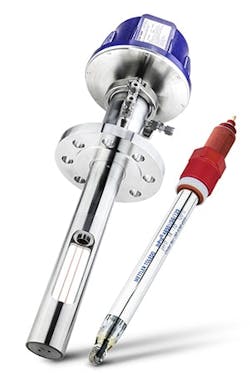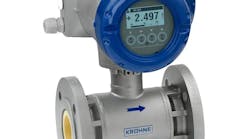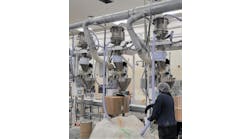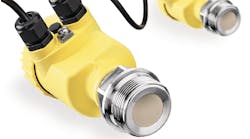Durable Probes Prove Safe And Efficient For pH And Moisture Analysis
Conditions are very challenging for pH and gas analysis sensors in chlor-alkali processes. Mettler Toledo has a long history in the chlor-alkali industry and offers new solutions that promise to reduce sensor maintenance, improve process performance, and ensure a safe work environment.
Chemical Processing spoke with Stefan van der Wal, head of industry management at Mettler Toledo Process Analytics in Switzerland, to learn more about his company's role in the color-alkali industry and how they are continuing to improve their products to best serve customers.
Q: Let’s get a little bit of background in terms of Mettler Toledo's position in the chlor-alkali industry. Can you talk about the history?
Head of industry management at Mettler Toledo Process Analytics in Switzerland.
A: We've always worked closely together with the chlor-alkali industry and with the technology owners. Dr. Ingold, the founder of our business unit in a way, invented the combination pH electrode shortly after we came into contact with the chlor-alkali industry because of the process being so dependent on pH. There was a strong need for a reliable process pH sensor.
Q: How is process pH responsible for process performance?
A: Chlorine is produced through electrolysis of concentrated brine, table salt solution, if you want. The pH of the process is important because it directly affects chlorine output and purity. But it is also important in sustaining equipment integrity. The highest chlorine yield requires a very low brine pH. At the same time, the ion exchange membrane in the electrolyzer will have a short life at such low pH, and that's a costly replacement part. So the trick is to find the balance between chlorine output and equipment longevity. And that requires tight pH control and a very reliable pH sensor. What it means is that pH directly affects process consistency, process uptime, product purity, equipment integrity, and maintenance needs. So, in short, it affects plant profitability in many aspects.
Q: Now, if the process medium is just saltwater, that brine solution you were talking about, why does it need a special sensor?
A: The process conditions are very challenging for pH sensors; concentrated brine, temperatures close to boiling point, and the abundance of chlorine and other strong oxidants. So, typically, pH probes require lots of maintenance and do not live very long in these applications. Already very early, we developed a process-resistance sensor that pretty much became the industry standard.
Q: What is special about this probe? What makes it special that will combat these types of situations?
A: A pH sensor's weak spot is the reference system. It's open to the process, and process chemicals can get in. It causes drift and ultimately destroys the probe. In the chlor-alkali process, it's the oxidants, such as chlorine, that kill the probe. Our probe features a pressurized reference system. This means it's harder for process chemicals to enter the probe and attack the reference electrode.
Q: Is this sensor still in use today?
A: It indeed is. And I guess it's still the standard in many operations. Not everybody is pleased with it, so...as it has a higher maintenance requirement, it needs refilling of sensory electrolyte and it needs re-pressurization. This seems a bit old-fashioned and people are more reluctant to do this kind of work nowadays. But conventional sensors cannot cope with the process very well, and they drift relatively fast. If not recalibrated in time, this will cause process variability and drive up operating costs, which is why we've launched a uniquely different solution a few years ago that, in fact, is tailored to and developed in cooperation with the chlor-alkali industry.
The InPro 4850i is a dual-membrane pH and ORP sensors specifically designed for chlor-alkali processes. It uses the sodium concentration in the process (brine) as a reference. The GPro500 Moisture TDL Analyzer is a probe-type analyzer designed for direct measurement of H2O in gas streams, including applications such as chlorine gas monitoring to prevent corrosion. Learn more: www.mt.com/PRO-Chlor-Alkali
Q: So what is unique about the solution?
A: The InPro 4850i sensor has a very different reference system. Similar to the pH glass membrane, the reference also consists of a glass membrane. This reference glass is so-called pNa glass, which is sensitive to sodium ions. In other words, it uses the sodium in the chlor-alkali brine to generate the reference potential. Fact of the matter is that the sensor is hermetically sealed and nothing can enter the sensor and damage the internals. We refer to it as a dual-membrane or differential pH sensor.
Q: Hasn't this technology been around already? So what makes the Inpro 4850i new?
A: You're quite right. The differential pH technology with pNa glass is in our portfolio since 40 years. It never really was a runner as its high-impedance millivolt output from two glass membranes is extremely sensitive. Despite extra shielding, the sensor cable often acts like an antenna causing very noisy measurements. Looking angry at it, sort of causes the pH value to shift, if you like. Besides that, it would need a special transmitter to receive the high-impedance reference potential. But in 2006, we developed our ISM technology, though. ISM stands for Intelligence Sensor Management, a process analyzer platform that uses the power of digital intelligence sensors to improve measurement performance and minimize maintenance.
The ISM sensor electronics convert the analog measurement value into a digital output, which is inert to interference such as cable movement and electromagnetic disturbance. So introducing the ISM technology in a pH sensor with sodium glass reference gave us the ultimate pH sensor for chlor-alkali industry. Its performance is spectacular. And we received feedback from customers telling us that the sensor's stability is like nothing they've ever seen. No need for calibration for over a year, despite continuous process exposure. Imagine the savings in our calibration weekly versus nothing for a year, and that for each measurement point in the brine cycle.
Q: Taking it from weekly, 52 times a year, to maybe once a year, how does an operator get used to that? When do you know that it needs recalibration?
A: That's a very good question. That's another benefit, in fact, that we get from our ISM sensors. The digital intelligence insight allow the sensor to do a continuous performance assessment. So the sensor continuously checks itself and the sensor remembers the process conditions it has been exposed to. So based on the experience of the sensor, the sensor will estimate when maintenance is due. Not only when it needs to be recalibrated, but it will also estimate its remaining lifetime. So the sensor still is a consumable. I mean, in the end, the sensor will slowly drift and its performance will go down. The sensor will estimate when that will happen under the given process conditions. So it will give you an idea of when maintenance is needed, or will allow you to really do predictive maintenance. So it will tell you when does it need calibration and how long will the probe last under the given process conditions.
Q: Does Mettler Toledo deal with applications outside of the brine cycle?
A: Absolutely. We also offer solutions for conductivity measurement for concentration determination and leak detection, turbidity meters for brine purity. And we even do gas analyses in chlorine.
Q: And now, can you elaborate on gas analysis? What does that entail?
A: In 2011, we released our GPro 500 analyzer. Back then, it was only available as in situ oxygen analyzer. It was a radically new design and a new use of tunable diode laser technology. Today, our GPro 500 analyzer portfolio not only measures additional gases, we also have numerous options to install the analyzer, both inline and online. So we now have a unique, scalable gas analyzer solution that opens the door to many new process applications and control strategies.
Q: Where does the GPro 500 fit into the chlor-alkali process?
A: Two measurements are important. The first one is the measurement of oxygen and chlorine. Oxygen may be formed in the electrolysis. This may be the result of wrong analyte pH values, and it means the chlorine needs further purification. Our GPro 500 analyzes chlorine for oxygen continuously and inline. We also have a GPro 500 for moisture analysis of chlorine to measure chlorine dryer performance. This is an extremely important measurement because wet chlorine is very corrosive.
Q: How is that different from other technologies?
A: In many ways, in fact. First of all, through the options that we have of installing the analyzer. We can choose an in situ installation using a probe-style mounting or a flow-through design for small line sizes. TDL technology has been on the market probably for 40 years, but typically the technology was reserved for very wide line sizes or ducts. The GPro 500 goes down to two-inch lines. Traditionally, oxygen analysis in chlorine gas is done with a paramagnetic analyzer. This is an extractive measurement. So it needs a sample flow from the process to the analyzer. That sample flow needs conditioning as, for example, moisture is not supposed to enter the analyzer.
If the sample conditioning systems fails, the analyzer will likely be damaged and will need repair. As the GPro 500 measures in situ, we don't need a sampling system and all the maintenance that goes with it. The inline installations also provide the fastest response time as there is no sample flow, or the measurement is virtually instantaneous. One of the biggest benefits, though, is the fact that the GPro 500 carries its own reference inside. That means that the unit does not meet periodic recalibration really. Complicated auto-calibration systems and expensive calibration gases are not required. So the unit really is a fit and forget type instrument.
Q: Do those same advantages apply to the moisture analysis with the GPro 500?
A: Oh, absolutely. The response time is one of the biggest differentiators. Traditional chlorine moisture measurement is done with a phosphorus pentoxide analyzer. Again, an extractive measurement. Due to the adhesion of moisture, the response time is usually very slow. The GPro 500, especially in situ, will respond immediately. Another benefit of the GPro 500 is the uptime and the lack of consumable parts. The measurement element in a phosphorus pentoxide analyzer has a hygroscopic coating that deteriorates over time. It needs to be replaced, which means the analyzer will be offline for a while. And in that time, process moisture may slip through, or alternatively, the process needs to shut down. The GPro 500 doesn't have any of these issues and that results in far lower cost of ownership.
Q: Do you have anything that you want to add?
A: Maybe this: Many process industries are working towards a sustainable green chemistry, but often it's a struggle. Implementing more inline analysis is a good start and really can make a big difference. Getting real-time process quality feedback allows for fast process control and immediate action that will lead to less waste and lower energy consumption because less off-spec product needs to be reprocessed. It may be so that the use of an inline analyzer for process control purpose may never have been considered because older analyzer technologies may not have been suitable. New technologies mean new possibilities and new ways to process control.
Finally, anyone who recognizes the measurement and process control challenges that we've addressed, get in touch with Mettler Toledo Process Analytics, we will be really very pleased to work with you.
For more information, visit www.mt.com/PRO-Chlor-Alkali





